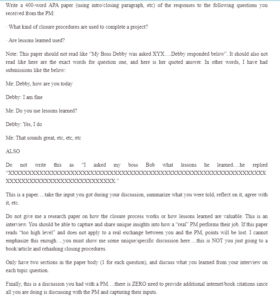Closure Procedures
Project management requires overseeing the implementation of every stage, from the project initiation stage to closure. The project manager needs to ensure that the project team understands the significance of each stage and their role in completing the stages within the project timeline. Various closure procedures are available to a project manager to complete different projects, each presenting new lessons on project management.
Closure Procedures
Closure procedures vary based on the type of project and stakeholders’ requirements. However, common steps in the closure procedures apply to most projects. One of the steps is reviewing project requirements to determine if they have all been met in the complete project. The requirements are often reviewed before notifying the project owner that the project is complete to create time for adjustments if the requirements have not been met. The second step is compensating the project team based on the terms of the agreement they signed at the beginning of the project. The third step is reviewing the complete project with the owner or owners to ensure they are satisfied with the work. The fourth step is releasing the remaining resources, which may include construction materials in a construction project.
In some projects, the project team may be acknowledged in launching the project, especially when there is a need to recognize the effort and sacrifices made by those involved. This mainly occurs in projects that may require progressive improvement requiring the team’s help. For instance, if the project entails manufacturing a new product, the project team needs to be kept close to handle any improvements that customers may request.
Using Lessons Learned
The success of a project relies on learning from the mistakes made by the project team and remaining hopeful that the project will be completed successfully, no matter the challenges the team may experience. It is, therefore, important to use every lesson learned. In most cases, the lessons revolve around the proper use of resources and collaboration in decision-making. Some mistakes usually occur because of the mismanagement of funds or poor communication of the project’s objectives. In such instances, the project delays create pressure on the project owner. The best thing to do is to learn from the mistake to avoid it in the future and focus on the most effective way to resolve the issue before it gets out of hand.
Conclusion
Project closure is dictated by whether the stakeholders are satisfied with what has been achieved. One of the main things that project team members should consider to ensure that the project is completed successfully is learning from their mistakes and being persistent despite the challenges they may encounter.
ORDER A PLAGIARISM-FREE PAPER HERE
We’ll write everything from scratch
Question
Write a 400-word APA paper (using intro/closing paragraph, etc) of the responses to the following questions you received from the PM:

Closure Procedures
· What kind of closure procedures are used to complete a project?
· Are lessons learned used?
Note: This paper should not read like “My Boss Debby was asked XYX….Debby responded below”. It should also not read like here are the exact words for question one, and here is her quoted answer. In other words, I have had submissions like the below:
Me: Debby, how are you today
Debby: I am fine
Me: Do you use lessons learned?
Debby: Yes, I do
Me: That sounds great, etc, etc, etc
ALSO
Do not write this as “I asked my boss Bob what lessons he learned….he replied “XXXXXXXXXXXXXXXXXXXXXXXXXXXXXXXXXXXXXXXXXXXXXXXXXXXXXXXXXXXXXXXXXXXXXXXXXXXXXXXXXXXXXXXXXXXXXX.”
This is a paper….take the input you got during your discussion, summarize what you were told, reflect on it, agree with it, etc.
Please do not give me a research paper on how the closure process works or how lessons learned are valuable. This is an interview. You should be able to capture and share unique insights into how a “real” PM performs their job. Points will be lost if this paper reads “too high level” and does not apply to a real exchange between you and the PM. I cannot emphasize this enough….you must show me some unique/specific discussion here….this is NOT you just going to a book/article and rehashing closing procedures.
Only have two sections in the paper body (1 for each question), and discuss what you learned from your interview on each topic question.
Finally, this is a discussion you had with a PM….there is ZERO need to provide additional internet/book citations since all you are doing is discussing with the PM and capturing their inputs.

